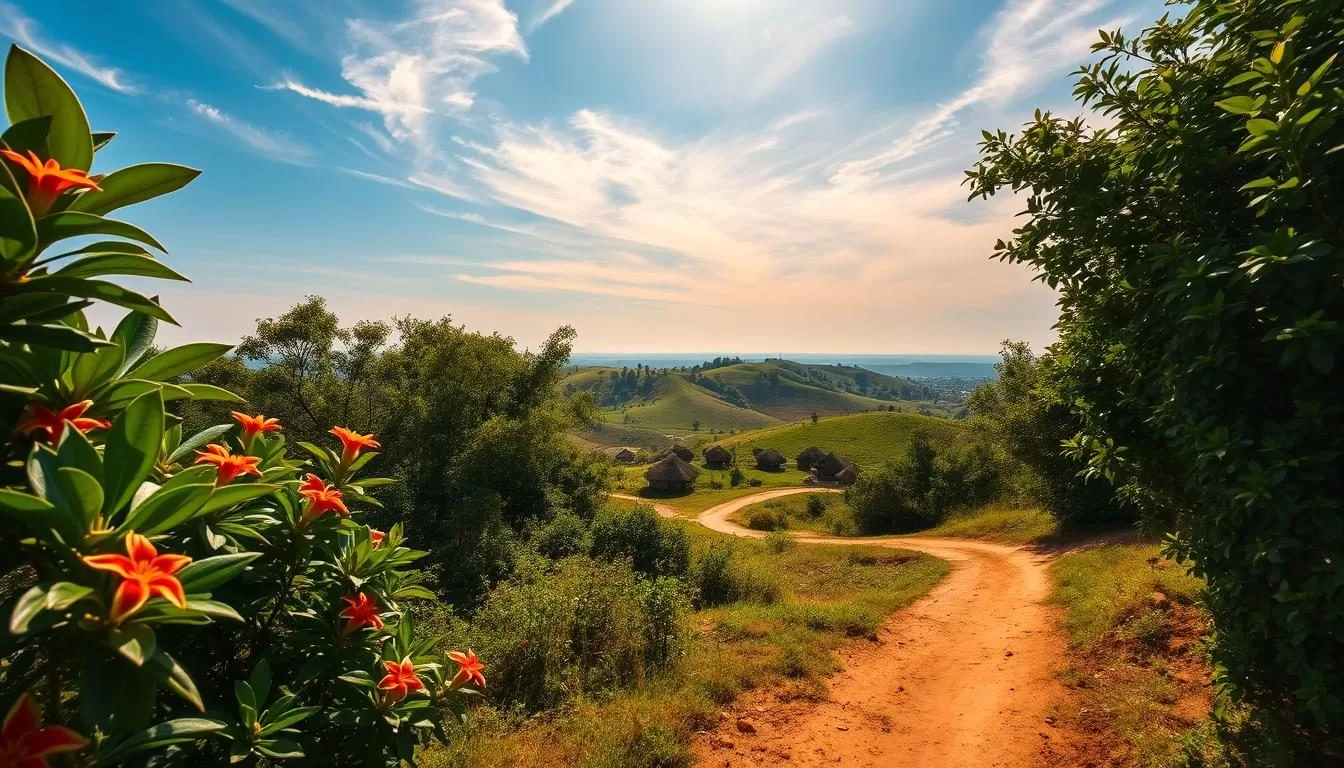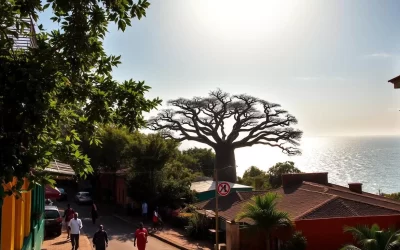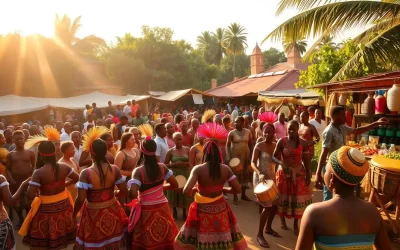Planning a trip to Guinea-Bissau requires understanding its distinct seasonal patterns to make the most of your travel experience. With a tropical climate that’s hot all year round, the country’s dry season from November to May and rainy season from June to October offer different conditions for your visit.
When you visit Guinea-Bissau, you’ll experience a climate that’s characterized by intense heat, especially in the interior, while the coastal areas are relieved by the breeze. The time to visit largely depends on your preferences – whether you’re looking for a dry and hot period or a less hot but muggy experience.
Understanding the season and weather conditions will help you plan a travel itinerary that suits your needs, ensuring a memorable trip.
Understanding Guinea-Bissau’s Climate Patterns
To make the most of your trip to Guinea-Bissau, it’s crucial to grasp the country’s tropical climate and its seasonal variations. The country’s climate plays a significant role in determining the best time to visit and enjoy its beautiful landscapes and beaches.
Tropical Climate Overview
Guinea-Bissau is characterized by a tropical climate, with two main seasons: the dry season and the rainy season. The dry season, which begins in November and lasts until May, is marked by minimal rain, lower humidity levels, and consistent northeast trade winds that help moderate the temperatures. During this period, the Harmattan wind from the Sahara can occasionally bring dust-laden air, particularly from December to February.
Dry Season vs. Rainy Season
The dry season is an ideal time to explore Guinea-Bissau’s beautiful landscapes and beaches. In contrast, the rainy season from June to October brings heavy monsoon rains, especially from July to September, when they can cause widespread flooding. The rainy season is characterized by high humidity levels, reaching up to 80%, making the air feel hotter and more oppressive despite slightly lower actual temperatures.
Understanding the differences between these seasons will help you plan your trip accordingly. The transition periods between seasons, May and November, offer interesting weather patterns with occasional rain showers but generally favorable conditions for travel.
The Dry Season: November to May
As you plan your trip to Guinea-Bissau, understanding the dry season can significantly enhance your travel experience. The dry season, which spans from November to May, is characterized by favorable weather conditions that make it an ideal time to explore the country’s diverse landscapes and cultural heritage.
Weather Conditions and Temperatures
During the dry season, Guinea-Bissau experiences warm temperatures, ranging from 20°C to 30°C (68°F to 86°F), making it comfortable for outdoor activities. The dry months are marked by minimal rainfall, plenty of sunshine, and a gentle breeze, creating perfect conditions for exploring the country’s outdoor areas.
The temperatures are relatively stable, with slight variations across different regions. The coastal areas tend to be cooler than the inland regions, thanks to the moderating influence of the ocean.
Advantages of Visiting During Dry Months
Visiting Guinea-Bissau during the dry season offers numerous advantages. The dry conditions make it easier to navigate the country’s terrain, whether you’re exploring the outdoor activities in the Bijagos Archipelago or visiting historical sites in Bissau. The dry season is also the peak time for cultural events and festivals, providing a unique opportunity to immerse yourself in the local culture.
In January, the country celebrates its independence with colorful parades, traditional music, and dance performances, offering a rich cultural experience. Moreover, the dry season is ideal for birdwatching, as many migratory bird species can be spotted during this time.
Popular Activities and Experiences
The dry season in Guinea-Bissau is perfect for a variety of activities. You can enjoy beach activities along the coastline and islands, such as swimming, fishing, and boat excursions, in the clear waters. The Bijagos Archipelago becomes a prime destination for ecotourism, offering exceptional opportunities for wildlife viewing, particularly rare bird species and marine life.
| Activity | Location | Best Time |
|---|---|---|
| Birdwatching | Bijagos Archipelago | January |
| Beach Activities | Coastline and Islands | November to May |
| Cultural Festivals | Bissau | January 20th |
For photography enthusiasts, the dry season offers the best travel experience, with clear skies providing excellent lighting conditions for capturing Guinea-Bissau’s landscapes and cultural moments. Whether you’re interested in cultural immersion, outdoor adventures, or simply relaxing on the beach, the dry season is an ideal time to visit Guinea-Bissau.

The Rainy Season: June to October
The rainy season in Guinea-Bissau, spanning from June to October, brings significant changes to the country’s landscape and climate. This period is characterized by substantial rainfall, transforming the environment into a lush, vibrant green.
Weather Patterns and Precipitation Levels
During the rainy season, Guinea-Bissau experiences heavy precipitation, with the majority of the country’s annual rainfall occurring between June and October. The rain is often accompanied by high humidity and warm temperatures, creating a tropical environment.
| Month | Average Rainfall (mm) | Average Temperature (°C) |
|---|---|---|
| June | 150 | 28 |
| July | 200 | 27 |
| August | 250 | 26 |
| September | 220 | 27 |
| October | 180 | 28 |
Challenges and Considerations
While the rainy season presents several challenges, including difficult travel conditions and potential flooding, it also offers opportunities for adventurous travelers. Travelers should be prepared for the rain and potential disruptions to their plans.
Unique Experiences During the Wet Season
Despite the challenges, the rainy season provides a unique experience for visitors. The landscape becomes lush and green, and the reduced tourism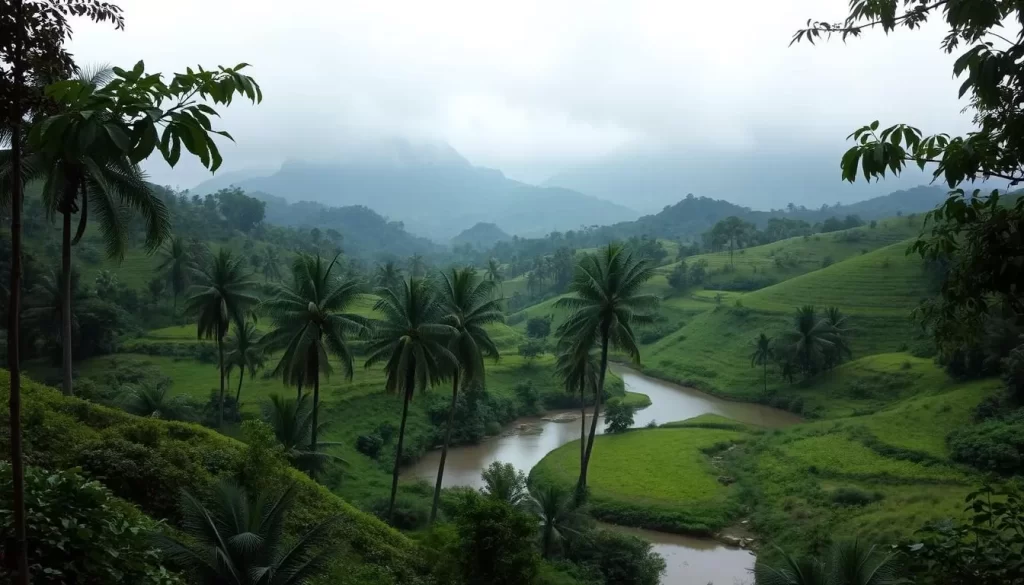
Some of the unique experiences during this period include:
- Lush, vibrant landscapes ideal for photographers and nature enthusiasts
- Different wildlife viewing opportunities as species become more active
- More authentic cultural experiences due to fewer tourists
- Budget-friendly options for accommodations and tours
- The Bijagos Archipelago takes on a mystical quality with misty mornings and dramatic skies
For travelers looking for an off-the-beaten-path experience, the rainy season in Guinea-Bissau offers a chance to explore the country’s natural beauty and culture in a unique and authentic way, potentially boosting local tourism in the long run.
Guinea-Bissau: Best Months for a Weather-Savvy Trip
The best time to visit Guinea-Bissau is a critical decision that can significantly impact your travel experience. Understanding the country’s climate patterns is key to planning a successful trip.
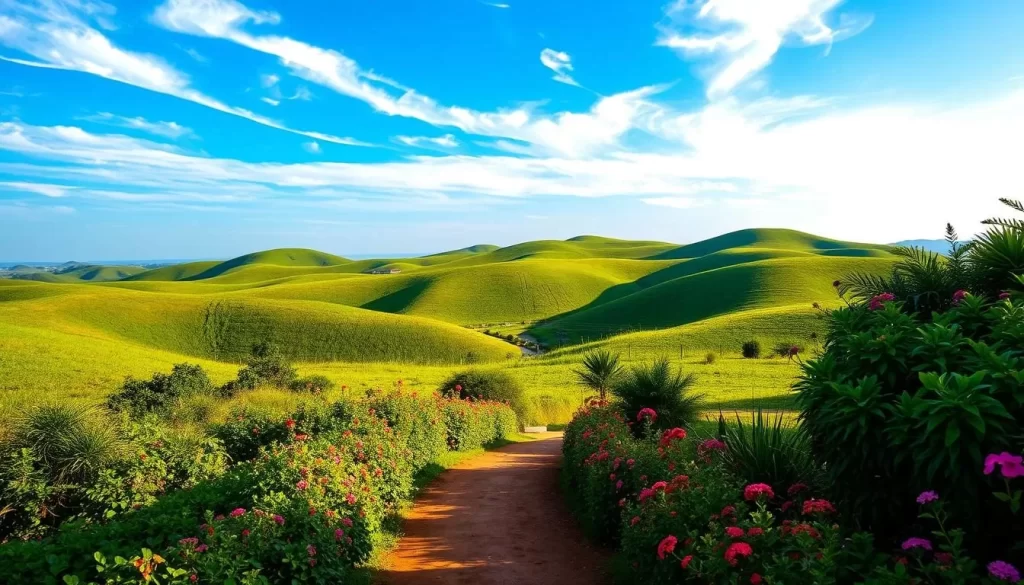
December to February: Peak Dry Season
December to February is considered the peak dry season in Guinea-Bissau, offering pleasant weather with minimal rainfall and comfortable temperatures ranging from 25-30°C. This period is ideal for outdoor activities such as exploring the country’s diverse landscapes and wildlife. You can enjoy the lush green landscapes that are still present from the rainy season, although they start to dry out as the dry season progresses.
The dry season is also a great time for cultural experiences, as the comfortable weather makes it easier to engage in outdoor festivities and local events.
March to May: Transition Period
The months of March to May mark a transition period in Guinea-Bissau’s climate, as the dry season starts to wane and the temperatures begin to rise. While it’s still relatively dry, the increasing heat can make outdoor activities more challenging. However, this period offers a unique opportunity to experience the local culture and traditions without the peak season crowds.
You can enjoy the country’s vibrant music and dance performances, as well as explore the local markets and cuisine.
November: Early Dry Season Benefits
November is an excellent time to visit Guinea-Bissau, as it marks the beginning of the dry season. The country is still lush and green from the rainy season, making it a great time for nature enthusiasts and photographers. The comfortable temperatures and decreasing humidity levels create an ideal balance for outdoor exploration.
You can experience the country’s Independence Day celebrations on November 24th, which offer a unique glimpse into the local culture and traditions. With tourist facilities and services beginning to reopen after the rainy season, November provides a good balance of availability and lower crowds.
Regional Weather Variations Across Guinea-Bissau
Guinea-Bissau’s diverse geography leads to varied regional weather patterns. Understanding these variations is crucial for planning a trip that suits your preferences and activities.
Coastal Areas Including Bissau
The coastal regions, including the capital city Bissau, experience a relatively moderate climate compared to the inland areas. The coastal breeze provides relief from the heat, making these areas more comfortable during the dry season. However, the central-southern part of the coast receives more abundant rainfall, exceeding 2,000 millimeters (79 inches) per year.
Bijagos Archipelago Climate
The Bijagos Archipelago, located off the coast of Guinea-Bissau, has a unique climate influenced by its maritime surroundings. The islands enjoy a relatively stable temperature throughout the year, with the ocean having a moderating effect on the climate. This makes the archipelago a pleasant destination for those seeking a tropical island experience.
Inland Regions and Eastern Guinea-Bissau
In contrast, the inland and eastern regions of Guinea-Bissau experience more extreme temperature variations throughout the year. These areas are hotter during the day and cooler at night compared to the coastal regions. The eastern territories are particularly hot during the dry season, with temperatures often exceeding 40°C (104°F) from March to May.
| Region | Annual Rainfall | Temperature Variations |
|---|---|---|
| Coastal Areas | Up to 2,000 mm (79 in) | Moderate |
| Bijagos Archipelago | Varies | Stable |
| Inland and Eastern Regions | Below 1,500 mm (60 in) | Extreme |
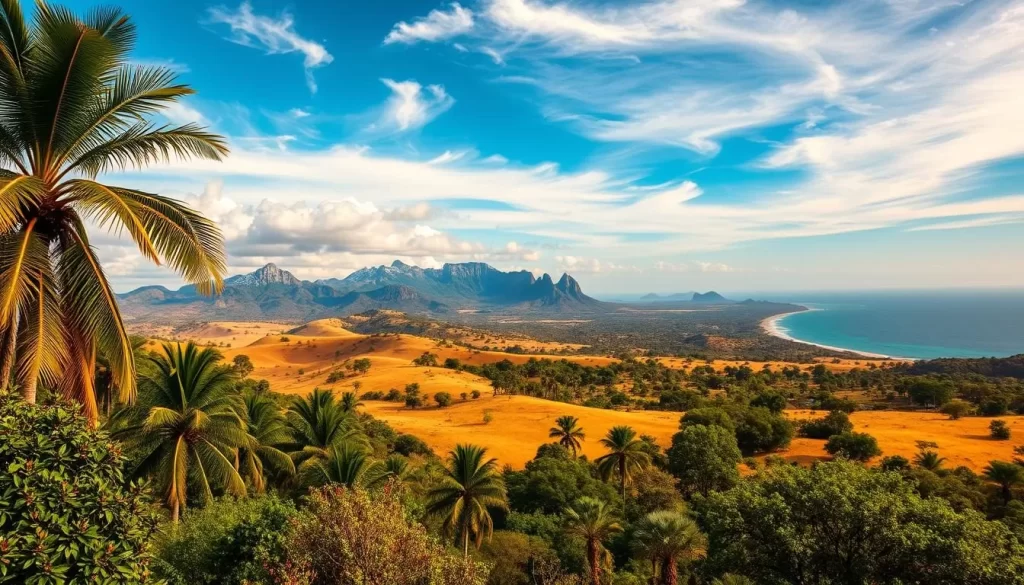
These regional variations in climate offer a range of experiences for visitors, from the bustling city life in Bissau to the serene landscapes of the Bijagos Archipelago and the cultural richness of the inland regions.
Planning Your Trip: Month-by-Month Breakdown
Planning a trip to Guinea-Bissau requires considering the country’s diverse climate conditions month by month. Understanding these variations can help you make the most of your visit, whether you’re interested in exploring the lush landscapes, enjoying the beaches, or experiencing the local culture.
January-February: Ideal Conditions
January and February are among the best months to visit Guinea-Bissau, with dry and pleasant weather prevailing across the country. The temperatures are warm but not excessively hot, making it an ideal time for outdoor activities such as exploring the Bijagos Archipelago or enjoying the beautiful beaches. With clear skies and minimal rainfall, these months are perfect for nature enthusiasts and those looking to relax in a serene environment.
March-May: Pre-Rainy Season
As the dry season progresses, March to May offers a great balance between comfortable weather and fewer tourists. Although temperatures start to rise, the dry conditions make it an excellent time for hiking and exploring the country’s diverse landscapes. It’s also a good period to experience the local culture before the rainy season begins.
June-October: Rainy Season Considerations
The rainy season, spanning from June to October, brings significant precipitation and higher humidity levels. While this period can be challenging for some activities, it’s also a great time for those interested in lush landscapes and lower prices for accommodations. Visitors should be prepared for occasional heavy rainfall and potential disruptions to outdoor plans.
November-December: Beginning of Dry Season
November and December mark the beginning of the dry season in Guinea-Bissau, offering a pleasant climate with gradually decreasing humidity and increasingly sunny days. The temperatures range from 25-32°C (77-90°F), making it an excellent time to visit. November 24th is National Day, providing a unique cultural experience. December is particularly dry, with the Harmattan wind influencing inland regions, making it a great time to explore the country’s natural beauty.
By understanding the monthly breakdown of Guinea-Bissau’s climate, you can plan your trip during the dry season for the best experience. Whether you’re looking for the ideal weather conditions or specific activities, timing your visit right is key to enjoying all that Guinea-Bissau has to offer. It’s the perfect time to visit Guinea-Bissau and make the most of your year.
Travel Tips for Different Seasons in Guinea-Bissau
When planning your trip to Guinea-Bissau, understanding the seasonal variations is crucial for a smooth and enjoyable experience. The country’s climate significantly influences the quality of your visit, whether you’re exploring the Bijagos Archipelago or visiting the capital city, Bissau.
What to Pack Based on Season
Packing appropriately is vital for comfort and enjoyment. During the dry season (November to May), lightweight clothing and sun protection are recommended. In contrast, the rainy season (June to October) requires waterproof gear and breathable clothing to manage the humidity and rain showers.
Health and Safety Considerations
Health and safety considerations vary by season. During the rainy season, there’s a higher risk of malaria and other waterborne diseases. Taking necessary precautions such as vaccinations and using insect repellents can mitigate these risks. In the dry season, staying hydrated and protecting yourself from the sun are key.
Booking Accommodations and Activities
Booking in advance is crucial, especially during the peak dry season (December to February), when tourism infrastructure can become fully booked. Consider using established tour operators who can offer flexible services and contingency plans, particularly during the shoulder seasons.
| Season | Accommodation Prices | Tourist Crowds |
|---|---|---|
| Dry Season (Nov to May) | Higher | Busy |
| Rainy Season (Jun to Oct) | Lower | Less Crowded |
| Shoulder Season (May & Oct) | Moderate | Moderate |
Conclusion: Making the Most of Your Guinea-Bissau Experience
To make the most of your Guinea-Bissau experience, it’s essential to be aware of the seasonal variations. The dry season, from November to May, is the best time to visit, with December to February offering the most pleasant weather.
However, it’s crucial to check for current travel advisories before finalizing your plans, as conditions can change. Guinea-Bissau offers a unique travel experience, with its pristine natural environments and rich cultural heritage.
When planning, consider the trade-offs between peak season and off-peak travel. Advance preparation is key, from securing visas to booking accommodations. Building flexibility into your itinerary allows you to adapt to local events and the relaxed pace of life.
The above is subject to change.
Check back often to TRAVEL.COM for the latest travel tips and deals.
